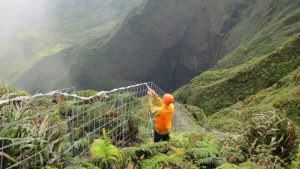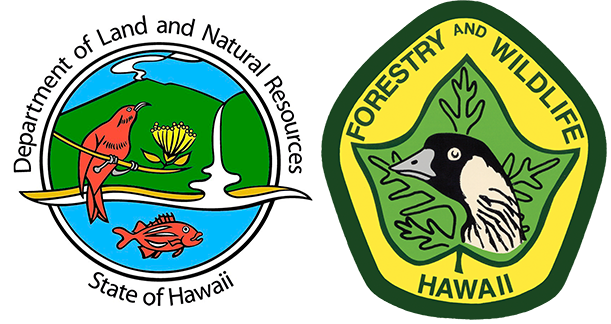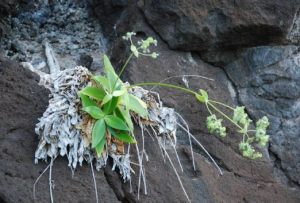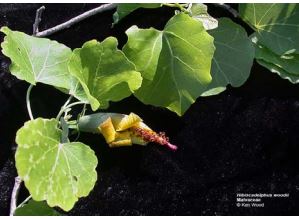Fencing

Kauaʻi is part of the most isolated island archipelago in the world, and is home to many rare plant and animal species. There are also many plants and birds that are very important to the native Hawaiian culture have gone extinct on Kauaʻi. The remaining native forests of Kauaʻi must be protected in order to preserve what is left.
While there are many causes of changes to the native Hawaiian ecosystems, on of the most critical factors has been the introduction of hoofed animals. The only mammals that are native to Hawaiʻi are marine mammals (whales, seals, dolphins) and one species of bat – the Hawaiian hoary bat (opeʻapeʻa). When hoofed animals were brought here by Polynesian voyagers and early European explorers, the locally adapted plants and animals were not equipped to handle the pressures of these new species.
Hoofed mammals, also called ungulates, disturb forests by trampling and eating vegetation; leaving behind barren dirt, which leads to erosion, landslides and rockfalls. Browsing animals such as goats and deer prefer the soft, tender native plants to the often tough or spiny introduced plants. Feral pigs also root for earthworms, turning up large patches of forest in their search for these underground treats. In other places, irreplaceable native Hawaiian archaeological sites are being toppled by goats and pigs.
Hunting feral ungulates for food and tradition plays an important role in balancing the needs of humans and conservation of forests (see our hunting page). But in some upland areas of Kauaʻi, where there are high concentrations of rare plants and animals, hunting alone is not doing enough to protect these precious resources. This is where fencing becomes critical.
Fencing is a proven way to stop hoofed animals from damaging native forests and to allow recovery of native plants and animals. Throughout the Hawaiian islands, ungulate proof fences have been constructed to preserve and protect native forests and watersheds.
On Kauaʻi 3% of native forests have been protected to date by fencing. The story map on the home page shows the existing fences on DLNR lands. This amount of protection is far less than other islands. Kauaʻi DOFAW strives to do better!
The long term strategic plan for where and when to fence is based primarily on these documents:
Kauai Watershed Alliance Master Plan
Honopu and Vicinity Predator Control Action Plan
The Economics of Fencing
■ For every $1 invested in fences and watershed protection, ~400 gallons of water is saved. ■ When water supply declines, expensive alternative water sources are needed. For example, the estimated cost of a desalination plant for Oʻahu is $40M to construct and $5.4M per year to operate. ■ Feral pigs alone cause $1.5B worth of damage nationwide.
DOFAW plans to erect hog wire or panels fencing in high biodiversity areas that is designed to keep out goats, pigs, and black-tailed deer. In certain remote areas, small predator-proof fences will be built to provide safe places for endangered seabirds to nest, a similar predator-proof fence was built near Kilauea Point.

DOFAW staff installing white tape on top of fence-line. This allows seabirds visibility of fences, when returning and leaving for nesting.
DLNR Hoofed Animal Fences
The online map also includes areas where hoofed animal removal is occurring or proposed through fencing and staff control. Hoofed animals (goats, black-tailed deer, cattle, and pigs) are an integral part of much of the lands that DLNR-DOFAW manages, but in some limited areas their populations must be controlled or restricted. For example, in certain areas they are eating extremely rare plants or ground nesting seabirds, and so are threatening to cause the extinction of these species. Many rare plants and birds with enormous significance to the native Hawaiian culture have recently gone extinct on Kauaʻi due to hoofed animals. In other cases, the populations are so high that the previously forested areas have been eaten and trampled and are now barren dirt, causing erosion, increased landslides and rockfalls.
This loss of forest is also problematic because the forest plants capture and purify fresh drinking water supplies.
Learn More About the 30×30 Watershed Protection and How Fencing Helps Protect Drinking Water
Additionally, greenhouse gases are emitted when plants are consumed, worsening climate change. In other places, irreplaceable native Hawaiian archaeological sites are being toppled by goats and pigs. While DLNR-DOFAW’s first approach to control hoofed animals is by using public hunting when safe, feasible, and effective, there are also additional areas where hoofed animal control may need to occur by staff. Many locations on Kauaʻi are too remote and steep for public hunting, so other tools such as fencing and staff control is needed.
Maintaining a recreational public hunting program that does not threaten the persistence of native species and ecosystems in Hawaiʻi is a complex endeavor. Public hunting can provide a useful tool in controlling game mammals on public and private lands where control is needed and funds are scarce. DLNR-DOFAW’s public hunting program supports and facilitates hunting on public and private lands by providing a structured program that promotes and encourages participation. The program aims to direct hunting toward less ecologically sensitive areas, while at the same providing structured hunter access to more remote/pristine sites where recreational hunting can help to control game mammal populations.
Proposed “Hooved Animal Free Zone”
In addition to fenced units, DOFAW will focus on staff control on this hooved animal removal zone. These are most appropriate for staff control because:
|
Kadua st. -johnii (Rubiaceae), an extremely rare plant found on Kauai’s coastal cliffs (Photo by Kenneth R. Wood) |
These areas are next to proposed fences. It is important to minimize outside animal pressure from entering fenced units. Staff animal control will occur on the ground. During this period, surveys will be done to determine whether aerial shooting will be needed in the future, particularly in steep inaccessible cliffs where it is unsafe to send staff to control goats.
Since these cliffs contain the last individuals of many rare plants, the Department’s goal is to have zero hooved animals in these locations. The Department is interested in gathering hunter input on ways to increase hunter access to this region, however access options are limited due to extremely steep cliffs. If surveys determine the need for aerial shooting, a separate plan will be prepared for approval in accordance with DLNR Policy.
Aerial shooting is only done as a last resort. A goal of this plan is to explore other tools before determining if aerial shooting is necessary.
Saving Hawaii’s Treasures From Extinction
The cliffs of Kalalau contains plants so rare that only a few individuals remain, such as the Hibiscadelphus woodii, a beautiful yellow hibiscus only known from the cliffs of Kalalau. Thought to be extinct, four individuals were found in a 2019 drone survey. These plants are in imminent danger of being eaten by the goat herds roaming the cliffs.
Map
Click the layers on an off to explore different aspects of the web map below.


